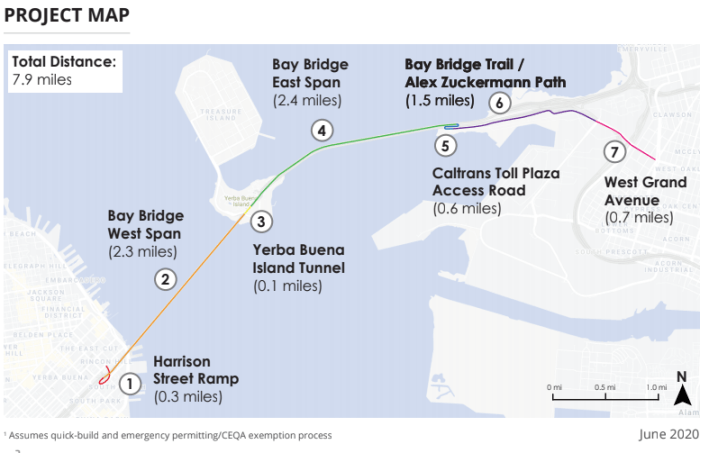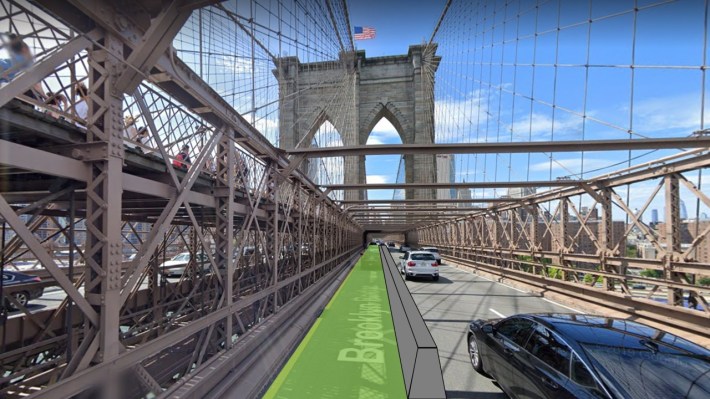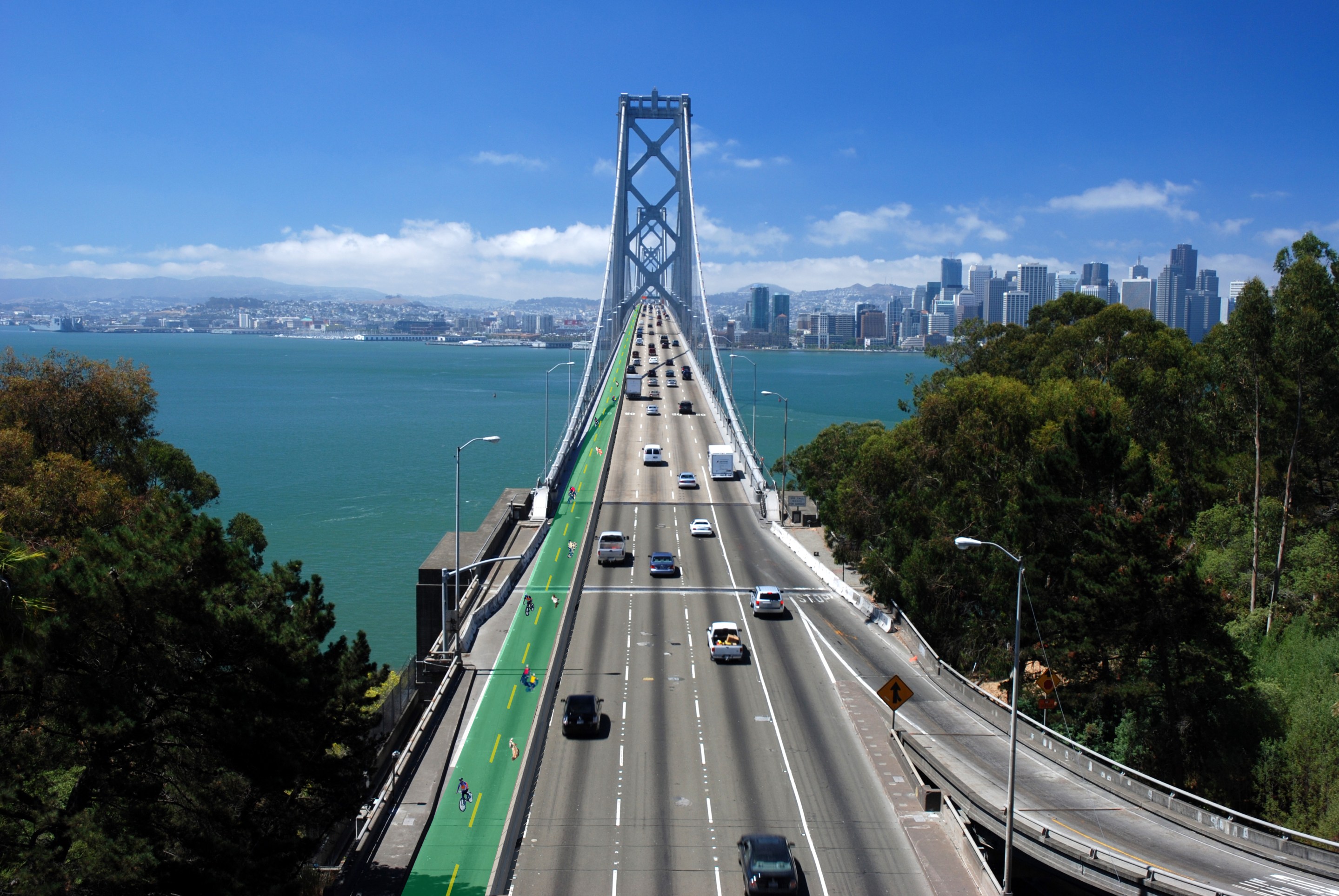Note: GJEL Accident Attorneys regularly sponsors coverage on Streetsblog San Francisco and Streetsblog California. Unless noted in the story, GJEL Accident Attorneys is not consulted for the content or editorial direction of the sponsored content.
New York City already has a bike and pedestrian path on the Brooklyn Bridge and the Queensboro Bridge, two of its East River crossings. But Mayor de Blasio decided that, given the COVID surge in cycling, they need more space; he announced this week that the city will convert one car lane on each bridge into an additional two-way cycletrack.
Which has Bay Area cycling advocates asking the obvious question: why couldn't that work on the Oakland Bay Bridge? They started a petition to make it happen.
Currently, cyclists and pedestrians can't travel directly between San Francisco and Oakland--the most they can do is get to the halfway point from Oakland, Yerba Buena Island, via the pathway on the eastern span. A ten-to-thirty year plan to spend between $400 and $500 million on a "Bay Skyway" bike and ped path--an incredibly complex giant catwalk attached to the side of the western span between San Francisco and Yerba Buena--remains a distant dream.
So far, calls to take a lane of the western span for bikes and peds the way New York has done have floundered with the agencies that control the bridge, MTC and Caltrans. "Caltrans officials have not told us they oppose this idea. They are very aware of it. They also have not done anything to move it forward," wrote Dave Snyder, Executive Director California Bicycle Coalition, in an email to Streetsblog.
"All the new bridge segments built over the past two decades - new Carquinez, new Benicia, new East Span - were built with new bike lanes. On the Richmond Bridge, MTC led the effort to take the shoulder in the west bound direction for bikes and pedestrians, while "we took the shoulder for auto travel on the east bound direction," wrote the MTC's Randy Rentschler in an email to Streetsblog. "But taking a lane on the Bay Bridge is not a strategy that we have supported."
He said the agency is instead focused on improving bus access.
But Ben Kaufman, Trail Development Manager of the Western Region at Rails to Trails Conservancy, and a leader in a growing constituency fighting for a "quick build" bike and pedestrian lane all the way to San Francisco, argues that one should not preclude the other.
Collaborating with traffic engineers, Bike East Bay, the California Bicycle Coalition, and others, last June the group completed an initial proposal for how a quick-build bike lane would work. It would use the existing Eastern Span bike path, carrying cyclists under the bridge via a Caltrans access road to the "fast lane" of the Yerba Buena tunnel. From there a Jersey-barrier protected lane would continue across the bridge. On the San Francisco end, the Harrison Street off-ramp, which comes off the left lane on the top deck, would be turned over to bikes.

Moving quickly and following New York's example, Kaufman believes the project can be "...on the ground in less than six months for under $10 million." He told Streetsblog he still supports building the Bay Skyway plan as a better, long-term solution, but he believes it's unacceptable to ban bikes and pedestrians from the bridge in the meantime. "MTC has asserted its goals for 60 percent of trips to be made by means other than driving an automobile by 2035. And Caltrans had a strategic management plan to triple the number of bicyclist commuters within fives years between 2015 and 2020--that's a goal Caltrans failed to meet."
He added that he's frustrated watching these agencies declare such goals, only to shunt projects that could actually make it possible. "It can be built quickly and affordably. It costs so little that money should not be an excuse. They have those funds," added Snyder.

Kaufman also envisions quick-build improvements in West Oakland (many already planned or underway) to help cyclists get to and from the bridge. And he foresees the installation of electric bike rental stations and scooter shares, probably at the West Oakland BART station. "I hope ebikes can be the game changer for bikes," added Rentschler, nothing they could be especially important on wind-swept Bay Area bridges.
Meanwhile, nearly all the state politicians who represent the region, from Senator Scott Wiener to Assemblymembers David Chiu, Rob Bonta and Phil Ting, signed a letter last September urging MTC and Caltrans to consider this quick-build plan, but so far to no avail.
From the letter:
Despite the immediate short-term demand for bicycling, and the long-term benefits of this dramatic drop in traffic, the region’s most important transportation link between San Francisco and the East Bay is currently restricted to cars, trucks, and transit vehicles. A “quick-build” micromobility path utilizing the left lane of the westbound Bay Bridge freeway deck can change that. It will provide a free, healthy, reliable, and safe connection for people who want to travel between the East Bay and San Francisco by bike, e-bike, or other micromobility vehicle. It can be built in just two or three months for as little as $10 million (equal to roughly two days of BART operating expenses) according to a preliminary study conducted by a Bay Area team of planners, engineers, and bike advocates.
There is growing support for this innovative solution to a traffic crisis that is predicted to cripple the Bay Area in the coming months. It is imperative that we investigate this opportunity while so many Bay Area businesses continue to encourage remote working and before a significant number of commuters make the shift to single-occupancy vehicles.
Kaufman believes MTC will follow Caltran's lead, and ultimately it's going to take the support of the new District 4 Caltrans director to get the first step done: allocating $150,000 for a full feasibility study. Given the changing needs and travel patters brought on by the COVID pandemic--and the explosion in cycling throughout the world - the proposal is primed to be taken seriously.
"We have basically the exact same proposal as NYC," he said, dismissing notions that doing the same type of project in the Bay Area is untenable. "We can do this. We can make it happen."
Be sure to sign the petition in support of this project.





